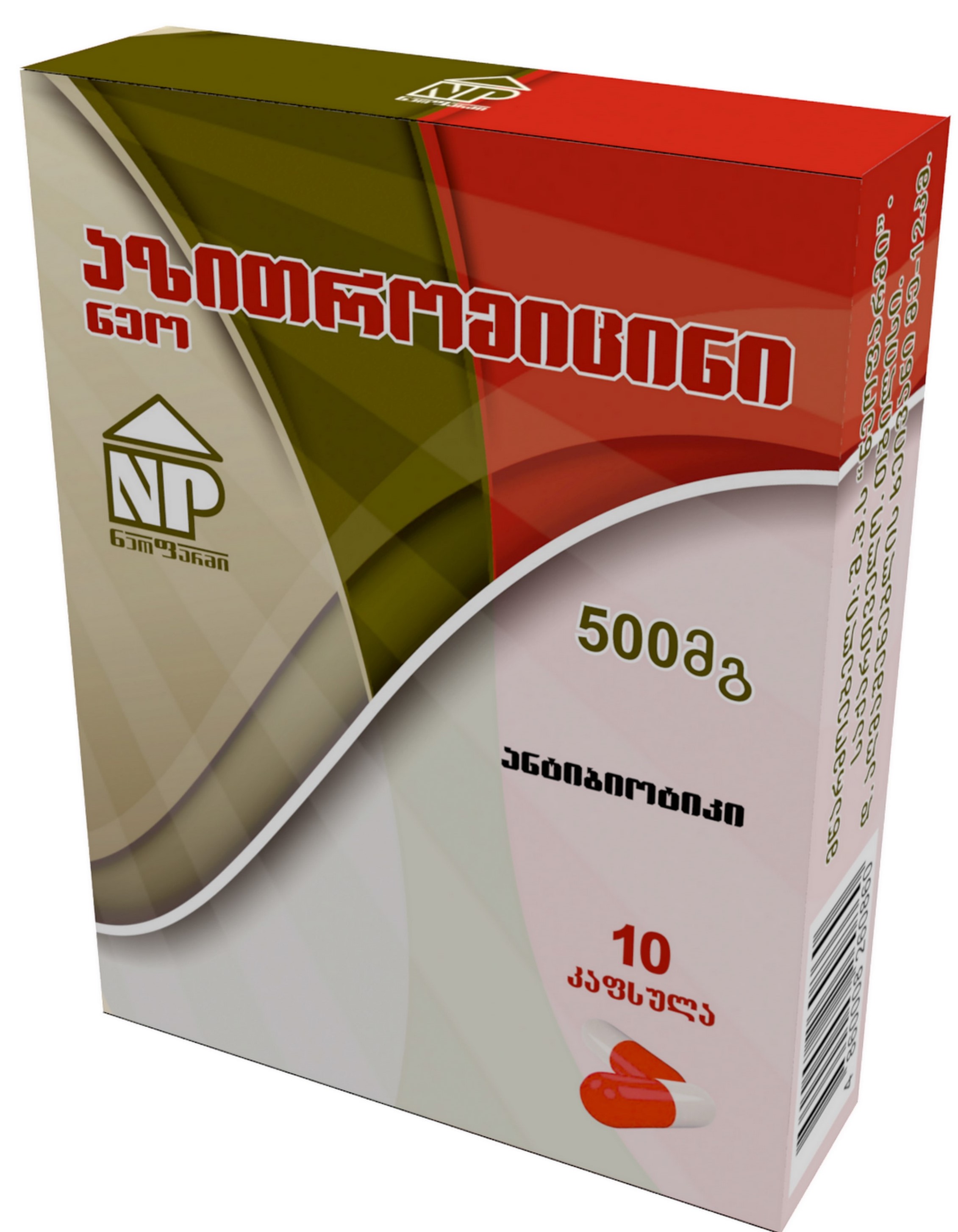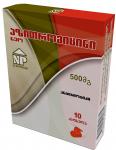Azitromicin-neo 250mg #10 caps
 Macrolid Antibiotic.
Macrolid Antibiotic.
Generic name: Azithromycine.
ATС Code: JO1FA1O .
Drug form: Capsules.
Pharmacological group:
Macrolide group antibiotic.
Composition: One capsule contains 250 mg. or 500 mg. active substance – Azithromycin
Pharmacological operation:
Azithromycin is macrolide group wide range action antibiotic. Gram-positive and gram-negative bacterium are sensitive toward Azithromycin: Staphylococcus aureus, Streptococcus pneumoniae, Streptococcus pyogenes, Haemophilus influenzae, H. parainfluenzae, Moraxella catarrhalis, Bacteroides fragilis, Escherichia coli, Bordetella pertussis, B. parapertussis, Borrelia burgdorferi, Hemophilus ducreyi, Neisseri gonorrhoeae, Chlamydia trachomatis; the preparation is also active toward Legionella pneumophila, mycoplasma pneumoniae, Treponema pallidum,Toxoplasma gondii.
Pharmacokinetics:
The preparation is absorbed well from gastrointestinal tract and rapidly distributed in tissues and organs. Food intake decreases Azithromycin absorption, that’s why preparation should be intake earlier 1 hour before eating or 2 hours after eating. Azithromycin biopenetration is - 37%, inside intake of 500mg - Cmax makes up 0,41 mg./kg. Azithromycin concentration in the infection nidus is 24-34% higher than its concentration in healthy tissue. 35 % of Azithromycin metabolizes in the liver by demethylation, more than 59 % is excreted unchanged with bile, 4,5% - with urine. Azithromycin bactericidal concentration in the inflammatory nidus preserved within 5-7 days after final dose intake.
Indication:
Infectious-inflammatory diseases caused by Azithromycin sensitive microorganisms:
• Respiratory system infections (bronchitis, bacterial and atypical pneumonia);
• Otorhinolaringology infections (angine, sinusitis, tonsillitis, pharyngitis, middle ear inflammation);
• Skin and soft tissues infections (erysipelas, impetigo, secondary infected dermatosis);
• Urogenital tract infections (uncomplicated Chlamydia infection, urethritis, cervicitis, sexually transmitted non- gonococcal infections);
• Laima's disease (borelioz)
• Stomach and duodenum diseases related to Helicobacter piroli.
Contraindication:
• Hypersensitivity toward macrolide group antibiotics.
• Liver and/or kidney’s function severe disorder
Order of intake and dosage:
Intake peroral. Preparation is prescribed one time in a day up to 1 hour before eating or 2 hours after eating. Dosage is individual in terms of disease:
Adults – 250-1000mg. 1 time in a day, round-the-clock.
Children: 4-10 mg.kg 1 time in a day, round-the-clock.
Intake duration: 2-5 days. Dosage in children is determined according to body weight.
For adults it is prescribed at time of respiratory system, skin and soft tissues infections:
500 mg one time in a day within three days, or on the first day – 500 mg., from II to V day – 250 mg (therapeutic course – 1,5g).
For children more than 12 years is prescribed 10mg/kg 1 time in a day during three days, or 10 mg/kg on the first day and then 5-10mg/kg 1 time in a day during 4 days (course dose 30 mg/kg).
At time of urogenital tract infections: single time 1g.
Complications caused by Chlamidia trachomatis, at time of prolonged urethritis, cervicitis:
There is prescribed 1g 1 time in a day with 7 days intervals, I-VII-XIV day (therapeutic course includes 3g. in total).
At time of Laima's disease: on the first day is prescribed 1g for one intake, from II to V day – 500 mg intake (therapeutic course includes 3g. in total).
Chronic transition erythema: children - total dose of the drug makes up 60mg/kg 1 time in a day. On the first day - 20mg/kg and from II to V day – 10mg/kg. In adults – on the first day is prescribed 1g on one intake (one time in a day), from II to V day – 500 mg 1 time in a day (therapeutic course includes 3g. in total).
Side effects: Rash - rarely, nausea, vomiting, diarrhea pain in the epigastric area, meteorism. Side effects are reversible and disappear after treatment course completion or drug remove.
Special indications: Preparation isn’t intake with food. Intake together with antacid 2 hours’ interval is a must. In case of skipping doses, the skipped dose is intake immediately and the next dose - 24-hour interval.
In some patients there may be preserved hypersensitivity reactions after treatment, which requires specific treatment under the doctor’s supervision.
Pregnancy and lactation: Azithromycin reaches into placenta. The preparation is used only, when the expected therapeutic effect for the mother exceed the potential risk of the fetus. In case of preparation necessity, there should be stopped breast feeding during lactation period.
Interaction with other preparations:
Intake of “Azithromycin neo” together with antacids, ethanol and food slows down and decrease its absorption.
Macrolide and Varfaren interaction may amplify anticoagulating effect by simultaneous prescription of Varfarin and “Azithromycin neo”, so it is essential to control prothrombin level in patients. “Azithromycin neo” increases digoxin concentration due to its inactivation weakening by intestinal flora. Simultaneous intake of ergotamine and dihydroergotamine together with “Azithromycin neo” increases their toxic action.
Lincosamides weaken, but tetracycline and chloramphenicol amplify affectivity of “Azithromycin neo”, it is pharmaceutically incompatible with heparin.
Overdose: In case of overdose there may occur heavy nausea, vomiting, diarrhea, temporary hearing loss.
Treatment: In case of overdose gastric lavage is necessary. Treatment is symptomatic.
Package: 10 capsules on polyvinyl chloride blister, 1 blister in the box.
Order of issue: Pharmaceutical product group II - issued with a doctor's prescription.
Validity: 3 years.
Storage conditions: Store on 15-25ºC temperature in a dark, dry place and keep away from children.
In case of visual defects and expiry of validity date, the preparation can not be used.


